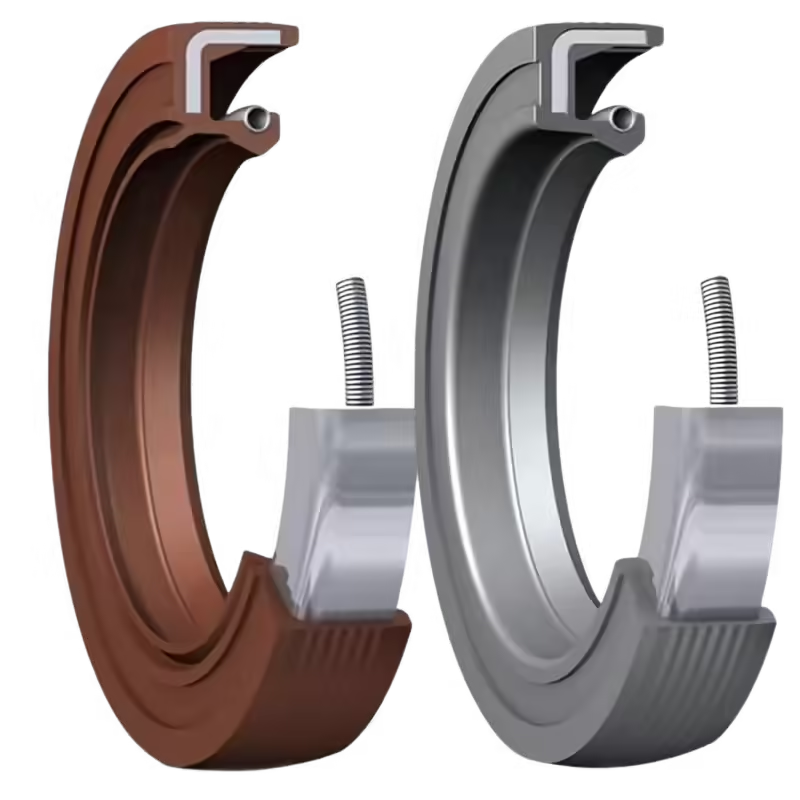Detailed Interpretation of Common Oil Seal Materials and Their Application Conditions
Oil seals are vital components in automotive, agricultural machinery, and industrial systems, preventing lubricant leakage and blocking contaminants from entering critical assemblies. Choosing the right oil seal material directly affects performance, durability, and cost-efficiency. In this article, we explore key oil seal materials—NBR, FKM, VMQ, ACM, EPDM, PTFE, and AEM—with detailed data, authoritative references (such as ISO 3601 and DIN standards), enhanced explanations of technical terms, and visual aids to help engineers and technical personnel make informed decisions.
1. Introduction to Oil Seals and Their Importance
Oil seals (also known as shaft seals) safeguard mechanical systems from lubricant loss and external contaminants. Whether used in automotive engines, hydraulic pumps, or industrial gearboxes, a reliable seal ensures optimal system performance, reduces maintenance costs, and extends service life.
- Relevant Standards:
- ISO 3601: Defines dimensional tolerances and performance criteria for seals.
- DIN Standards: A series of German standards covering various aspects such as chemical compatibility, mechanical properties, and testing procedures (e.g., DIN 53505, DIN 53521, DIN 73379).
- Typical Applications:
- Crankshaft sealing in engines
- Hydraulic system sealing
- Gearbox sealing
2. Comprehensive Overview of Oil Seal Materials
Below is a summary of the most commonly used oil seal materials along with their key properties, temperature ranges, oil and chemical resistance, applicable testing standards, and typical applications.
2.1 Material Properties Table
| Material | Temp. Range (°C) | Oil Resistance | Chemical Resistance | Testing Standards | Common Applications |
|---|---|---|---|---|---|
| Nitrile Rubber (NBR) | -40 to 120 | Excellent | Moderate (weaker against acids/ozone) | ISO 3601, DIN 53505 | Automotive engines, hydraulic systems |
| Fluorocarbon Rubber (FKM) | -20 to 250 | Excellent | Excellent (resistant to fuels/aggressive chemicals) | DIN 53521 | Aerospace, turbochargers, fuel systems |
| Silicone Rubber (VMQ) | -60 to 200 | Moderate | Good (weaker resistance to oils) | ISO 3601, DIN 53504 | Medical devices, food-processing equipment |
| Polyacrylate Rubber (ACM) | -20 to 180 | Excellent | Good (resistant to oxidation/synthetic oils) | DIN 73379 | Automotive transmissions, standard oil seals |
| Ethylene Propylene Diene (EPDM) | -50 to 150 | Poor | Excellent (resistant to ozone/steam) | DIN 53508 | Cooling systems, outdoor sealing |
| Polytetrafluoroethylene (PTFE) | -200 to 260 | Excellent | Outstanding (resistant to chemicals/solvents) | DIN EN ISO 12086 | High-speed rotary seals, chemical industry |
| Ethylene Acrylate Rubber (AEM) | -40 to 160 | Good | Good (enhanced fuel resistance) | DIN 73378 | Automotive air systems, turbocharger hoses |
Note: “Excellent” and “Good” denote high and moderate performance levels respectively, while “Poor” indicates insufficient performance for heavy-duty applications.
2.2 Visual Aids
Chemical Compatibility Chart
Below is a simplified representation of the chemical and environmental resistance of each material:
| Material | Oil Resistance | Acid Resistance | Ozone Resistance | Heat Resistance |
|---|---|---|---|---|
| NBR | ●●●●○ | ●●○○○ | ●○○○○ | ●●●○○ |
| FKM | ●●●●● | ●●●●● | ●●●●● | ●●●●● |
| VMQ | ●●○○○ | ●●●○○ | ●●●●● | ●●●●● |
| ACM | ●●●●● | ●●○○○ | ●●●○○ | ●●●●○ |
| EPDM | ●○○○○ | ●●●●● | ●●●●● | ●●●●○ |
| PTFE | ●●●●● | ●●●●● | ●●●●● | ●●●●● |
| AEM | ●●●○○ | ●●○○○ | ●●●○○ | ●●●●○ |
- Legend:
- ● = Excellent Resistance
- ○ = Poor Resistance
Performance Curve Description
Performance Comparison: NBR vs. FKM at High Temperatures
- NBR: Demonstrates a steep decline in performance above 120°C.
- FKM: Remains stable up to 250°C, making it ideal for high-heat applications such as turbochargers and fuel injection systems.
Note: For detailed graphs, readers are encouraged to refer to the supplementary figures in the online version or contact us for high-resolution images.
3. Detailed Material Analysis
In this section, each oil seal material is analyzed in a consistent format covering key standards, performance highlights, limitations, common applications, and practical insights. This structured approach aims to provide a quick yet comprehensive overview for each material.
![]()
3.1 Nitrile Rubber (NBR)
- Standards & Testing:
- ISO 3601: Applied for general-purpose seals.
- DIN 53505: Focused on assessing oil resistance.
- Performance Highlights:
- Oil Compatibility: Excellent resistance to a wide range of oils and greases.
- Temperature Range: Operates reliably from -40°C to 120°C.
- Limitations:
- High-Temperature Performance: Performance declines above 120°C.
- Ozone Resistance: Vulnerable to ozone exposure without modifications.
- Common Applications:
- Automotive engines
- Hydraulic systems
- General industrial machinery
- Practical Insight:
When selecting NBR for applications with potential high-temperature fluctuations or ozone exposure, consider using anti-ozone additives or exploring alternative materials like FKM for enhanced durability.
3.2 Fluorocarbon Rubber (FKM)
- Standards & Testing:
- DIN 53521: Emphasizes fuel and chemical resistance testing.
- Performance Highlights:
- Chemical & Heat Resistance: Excellent performance up to 250°C and robust against aggressive chemicals.
- Longevity: Superior durability in demanding environments.
- Limitations:
- Cost: Higher material cost compared to NBR.
- Low-Temperature Behavior: Reduced performance in extremely low temperature scenarios.
- Common Applications:
- Aerospace components
- Turbocharger seals
- Fuel systems and high-performance automotive applications
- Practical Insight:
FKM is best suited for high-temperature and chemically aggressive environments. Despite its cost, the extended service life and reliability can justify its selection for critical applications.
3.3 Silicone Rubber (VMQ)
- Standards & Testing:
- ISO 3601: Ensures reliability under extreme temperature variations.
- DIN 53504: Covers tensile properties and mechanical performance.
- Performance Highlights:
- Temperature Adaptability: Operates effectively from -60°C to 200°C.
- Flexibility: Maintains excellent elasticity and flexibility even under extreme conditions.
- Limitations:
- Oil Resistance: Moderate performance; not ideal for environments with heavy oil exposure.
- Abrasion Resistance: Lower abrasion resistance compared to other elastomers.
- Common Applications:
- Food-processing equipment
- Medical devices
- Applications where temperature extremes are encountered but oil exposure is minimal
- Practical Insight:
VMQ is ideal for applications where temperature fluctuation is critical and cleanliness is a priority. Its use in non-oil-intensive environments ensures longevity without compromising safety or performance.
3.4 Polyacrylate Rubber (ACM)
- Standards & Testing:
- DIN 73379: Addresses oxidation and oil resistance aspects.
- Performance Highlights:
- Oil and Oxidation Resistance: Performs excellently against synthetic oils and oxidative environments.
- Temperature Range: Effective within -20°C to 180°C.
- Limitations:
- Ultra-High Temperatures: May require modifications or alternative materials when operating near the upper temperature limit.
- Common Applications:
- Automotive transmissions
- Standard oil seal applications in moderate environments
- Practical Insight:
ACM is a robust option for many standard applications, but engineers should evaluate its performance limits when considering ultra-high temperature conditions.
3.5 Ethylene Propylene Diene (EPDM)
- Standards & Testing:
- DIN 53508: Focuses on the material’s resistance to environmental factors such as ozone and steam.
- Performance Highlights:
- Ozone & Steam Resistance: Outstanding performance, making it ideal for outdoor and cooling system applications.
- Durability: Excellent longevity under environmental stress.
- Limitations:
- Oil Resistance: Poor compatibility with oil, limiting its use in heavily oiled systems.
- Common Applications:
- Cooling systems
- Outdoor sealing applications
- Practical Insight:
EPDM should be selected for environments where exposure to ozone, steam, or weather is a significant factor. It is not recommended for applications with substantial oil exposure.
3.6 Polytetrafluoroethylene (PTFE)
- Standards & Testing:
- DIN EN ISO 12086: Establishes criteria for chemical and heat resistance.
- Performance Highlights:
- Chemical Resistance: Outstanding resistance to a wide array of chemicals and solvents.
- Temperature Range: Maintains performance from -200°C to 260°C, suitable for extreme conditions.
- Limitations:
- Flexibility: Less elastic compared to elastomer-based seals, which might affect installation in dynamic applications.
- Cost: Generally higher due to advanced properties.
- Common Applications:
- High-speed rotary seals
- Chemical processing industries
- Practical Insight:
PTFE is an excellent choice for applications demanding superior chemical and temperature resistance. Its mechanical rigidity should be considered during design to ensure compatibility with dynamic system requirements.
3.7 Ethylene Acrylate Rubber (AEM)
- Standards & Testing:
- DIN 73378: Addresses fuel resistance and overall performance in automotive environments.
- Performance Highlights:
- Fuel Resistance: Provides balanced performance in fuel-rich environments.
- Temperature Range: Functions reliably from -40°C to 160°C.
- Limitations:
- Extreme Conditions: While balanced, it may not match FKM in extremely aggressive or high-temperature conditions.
- Common Applications:
- Automotive air systems
- Turbocharger hoses
- Practical Insight:
AEM offers a balanced performance suitable for general automotive applications. It provides a cost-effective alternative when ultra-high performance is not the primary requirement.
4. Tips for Optimizing Your Sealing System
A successful oil seal installation involves more than just selecting the right material. Consider the following pointers:
- Surface Roughness:
Studies aligned with ISO 3601 indicate that refining the shaft’s surface roughness can extend oil seal longevity by up to 300%. Ensure that the mating surfaces are within the recommended roughness limits. - Material Pairing:
In high-speed or highly corrosive environments, opt for advanced materials like PTFE combined with precision-engineered shafts. This reduces friction and improves overall system reliability. - Maintenance Checks:
Regularly inspect seal integrity and lubricant compatibility. Proactive replacement before significant wear occurs can prevent downtime and costly repairs. - Additional Considerations:
For materials like NBR, if high temperatures or ozone exposure are concerns, consider material modification techniques (e.g., using anti-ozone additives) or alternative materials such as FKM.
5. Conclusion
Selecting the ideal oil seal material requires a careful balance of temperature resistance, chemical compatibility, and application-specific demands. By leveraging data from ISO 3601, various DIN standards, and performance charts, engineers can make informed decisions to ensure long-lasting and efficient sealing solutions. For further customization or tailored recommendations, please do not hesitate to reach out.
References
- ISO 3601: Sealing principles and dimensional tolerances for rotary seals.
- DIN 53505 & DIN 53521: Standards related to oil and chemical resistance testing.
- DIN 53504, DIN 73378, DIN 73379, DIN EN ISO 12086: Additional standards covering material properties and testing procedures.
For more detailed information, please consult the respective standard documents or contact industry experts.
Contact Us
- Website: drorubber.com
- WhatsApp: +0086 15815831911
- WeChat: +0086 13784044874





